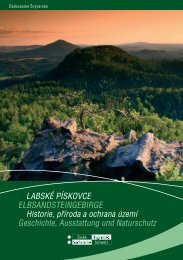ABSTRACT BOOK Sandstone Landscapes ... - Sandstones.org
ABSTRACT BOOK Sandstone Landscapes ... - Sandstones.org
ABSTRACT BOOK Sandstone Landscapes ... - Sandstones.org
Create successful ePaper yourself
Turn your PDF publications into a flip-book with our unique Google optimized e-Paper software.
TTomáš HerbenInstitute of Botany, Academy of Sciences of the Czech Republic, CZ-252 43 Průhonice, and Department ofBotany, Charles University, Benátská 2, CZ-128 01 Praha 2, Czech Republic (herben@site.cas.cz; fax:+420 2 67750031)Denudation/accumulation dynamics and vegetation patterns in sandstone regionsSince sandstones are generally water-permeable, rainfall water tends to soak instead of flowing horizontallyon the soil surface or at the soil/bedrock transition. As a result, horizontal transport of matter by water isthus reduced and the landscape is often a bizarre mosaic of cliffs, deep valleys or g<strong>org</strong>es and steep slopes.This strong vertical differentiation accounts for the well-known mesoclimatic differentiation and otherfeatures of sandstones. In addition to this, it underlies dynamic transport processes that strongly affectvegetation in sandstone regions.(i) First, the vertical differentiation enables matter transport that accounts for disturbance(erosion/sedimentation) dynamics that periodically rejuvenates vegetation at slopes and bottom parts of thevalleys. As a result, the sandstone vegetation is rather a mosaic of patches of different successional stages.This acts as a strong selective force on plant species that occur there; particularly the bottoms tend tooccupied by species that possess mechanisms that enable them to withstand disturbance (either byavoidance or tolerance). (ii) Second, the vertical differentiation leads to the creation of specific habitats(namely talus cones) due to matter (sand) transport. Owing to the relative constancy of the processes thatgenerate them, the talus cones are recurrent structures that may bear specific biota. (iii) Third, <strong>org</strong>anicmatter (e.g. litter, moss carpets etc.) is often transported over the cliff-bottom gradient; in this way nutrientsare carried from the cliffs to the valley bottoms. This may play an important role as the sandstone bedrockis often very poor in nutrients; valley bottoms are typically more nutrient-rich than the denudation areas onthe cliffs.All these three kinds of processes are essential for the typical vegetation differentiation found in sandstoneregions. As in similar types of habitats, protection of the biota and habitat should primarily concentrate onprotection of these processes. Strict conservationist approach is likely to fail in this context.PIvana Hladíková 1 and Tomáš Herben 21 Department of Botany, Faculty of Science, Charles University, Benátská 2, CZ-128 01 Praha 2, CzechRepublic (ivanahla@natur.cuni.cz)2 Institute of Botany, Academy of Sciences of the Czech Republic, CZ-252 43 Průhonice, and Department ofBotany, Charles University, Benátská 2, CZ-128 01 Praha 2, Czech Republic (herben@site.cas.cz; fax:+420 2 67750031)Matter transport and its influence on the sandstone vegetationTall rock formations (up to 200 m) and deep g<strong>org</strong>es are typical for the Adršpašsko-Teplické Rocks in NorthEast Bohemia. The bottoms of the g<strong>org</strong>es have richer flora than common elsewhere in sandstone regions,which are extremely poor of nutrients. Matter transport from the tops of the rocks and rock walls is likelyto affect the vegetation of the g<strong>org</strong>es.The aim of this study is to quantify the transport of <strong>org</strong>anic matter and nutrients to the bottoms of g<strong>org</strong>es inAdršpašsko-Teplické Rocks and identify its ecological meaning. Vegetation recordings were made at 151sites (0.5x0.5 m 2 ) in 11 treeless g<strong>org</strong>es differing in their depth, temperature and geomorphology. Mattercollectors were placed into these sites. The matter is collected fives a year, weighed and analysed todetermine its content of main nutrients. The main components fallen to the collectors are needles, leaves,mosses and liverhoots, twigs and humus and soil. The decomposition rate of spruce needles, spruce twigsand Mylia taylori is determined using the ”Litter bag” method.Keywords: sandstone vegetation, matter transport, litter bags method




